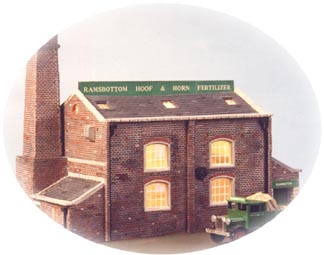|
Linka is versatile! The reusable rubber moulds are a fun, economical way to make dozens of realistic scale buildings and other structures.
|
 |
||||||||
|
Linka is a system of reusable rubber moulds that are used to cast interlocking plaster pieces. These pieces are glued together to make incredibly detailed and realistic looking HO/OO scale (1/76-1/72 or 20-22 mm) structures that resemble brick, stone, and timber buildings (see our Gallery page for examples). Although originally scaled for "British OO" (1/76), Linka moulds are ideal for scales as small as 1/87 and, with some modification, as large as 25 mm. Because the system is used to cast individual components such as windows, doors, walls, etc., it is very versatile. The pieces can be glued together in infinite combinations to make buildings of various sizes and shapes. The plaster castings are also easily cut so that the builder is not limited to the shapes of the original moulds. In the end, you are limited only by your imagination and skill. Start by mixing the plaster according to the package directions. Then carefully pour the mix into the cavities in the rubber moulds. After a brief "setting-up" time, gently flex the mould to remove the pieces. Set aside and allow them to dry completely. |
||||||||||
|
|
||||||||||
|
The castings can then be assembled into almost any type of building. Once the glued model has dried, apply the paint and weathering to create a very realistic and life-like structure.
Check our Using Linka page for more detailed construction information. |
||||||||||
| Product History | ||||||||||
|
Linka was first produced in 1979 by Thomas Salter, Ltd. of Scotland. It was marketed throughout Europe and North America and enjoyed tremendous early successes. Poor instructions and poor market research, however, soon led to the downfall as initial sales were not followed up by repeat business. Word of mouth from the dissatisfied consumers was that Linka produced shoddy results. The meteoric rise led to an equally rapid demise and the company found itself in bankruptcy by 1983. The remaining materials and tooling were sold to Stuart Manley of Alnwick, Northumberland in 1982 and the product was re-introduced to the market two years later. Now called "Linka Systems," the old instructions were replaced by tested and proven methods. These were taken from the extensive input from devoted Linka modelers around the world. The resultant body of work came to be known as the Linka Manual and covered a wide range of topics from basic construction to repairing damaged models to constructing massive stone viaducts. (Portions of the Linka Manual are reproduced, with permission, on our Using Linka page.) Many new modelers quickly learned that Linka did indeed produce quality results. Sales were steady, but the market failed to grow. With enough income to remain afloat and not much else, Linka Systems ceased operations in September 1993. Stuart Manley produced a "Last Linka Newsletter" in 1995 which details the rise and fall of Linka; from its beginnings with Thomas Salter, Ltd. to its end with Linka Systems in 1993. You can read the newsletter here. We contacted Mr. Manley in 2003 and inquired after the toolings. To our surprise, he took us up on our offer to relaunch Linka and has provided valuable guidance and materials to assist us with this latest effort... |
||||||||||
| Frequently Asked Questions | ||||||||||
|
What are the Linka moulds made
from? The Linka moulds are made from a flexible, rubber-like plastic called Evoprene 960G.
How are the moulds made? How long will the Linka
moulds last? What scale are the Linka
moulds? What kind of materials can I
use to make my castings? What if I have some other
question not answered here?
|
||||||||||
|
||||||||||
|
"Linka" is a registered trademark of Linka World, Inc. © 1993 Linka Systems © 2003-2013 Linka World, Inc. All rights reserved. All copyrighted materials are used here with permission and may not be reproduced or redistributed. |
||||||||||